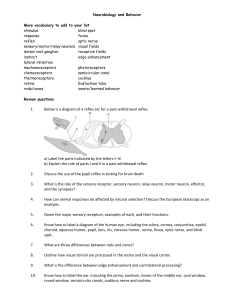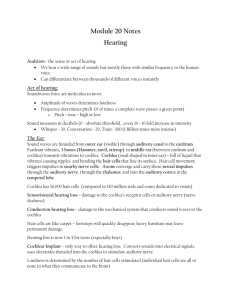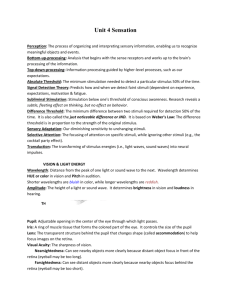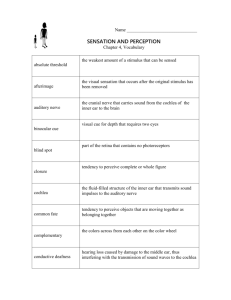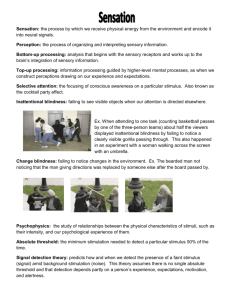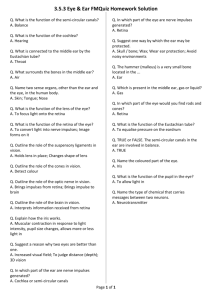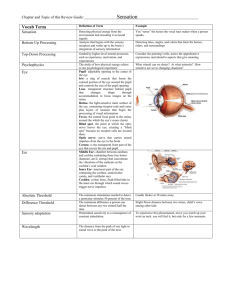Psychology (8th Edition) – David Myers Chapter 5 – Sensation (pg
advertisement
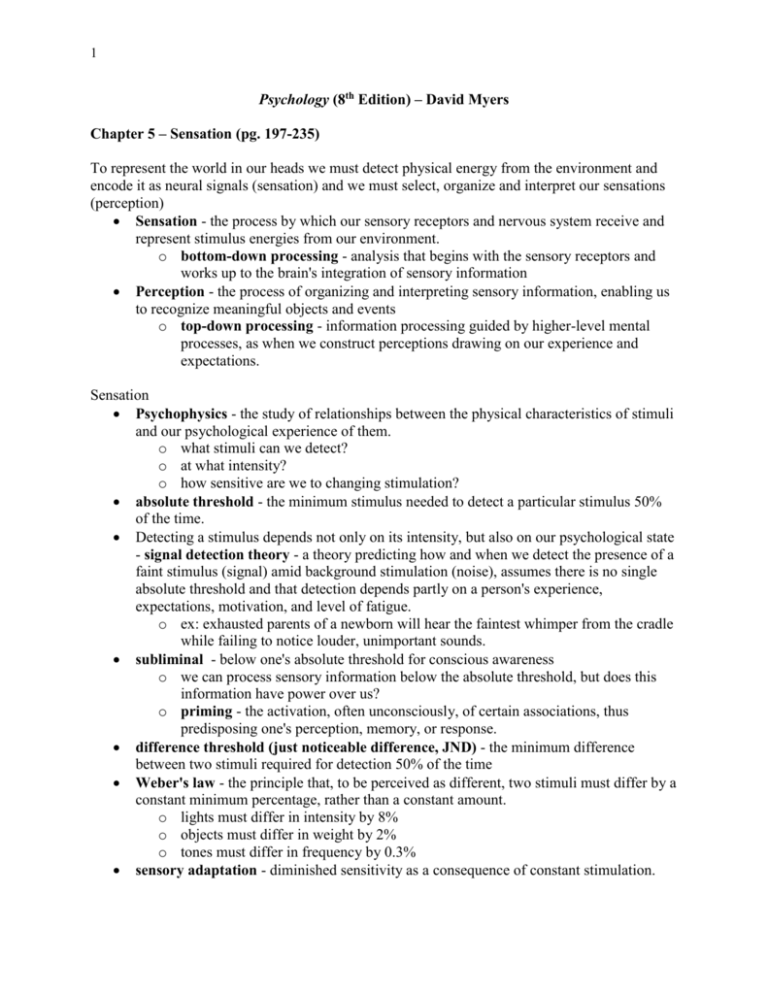
1 Psychology (8th Edition) – David Myers Chapter 5 – Sensation (pg. 197-235) To represent the world in our heads we must detect physical energy from the environment and encode it as neural signals (sensation) and we must select, organize and interpret our sensations (perception) Sensation - the process by which our sensory receptors and nervous system receive and represent stimulus energies from our environment. o bottom-down processing - analysis that begins with the sensory receptors and works up to the brain's integration of sensory information Perception - the process of organizing and interpreting sensory information, enabling us to recognize meaningful objects and events o top-down processing - information processing guided by higher-level mental processes, as when we construct perceptions drawing on our experience and expectations. Sensation Psychophysics - the study of relationships between the physical characteristics of stimuli and our psychological experience of them. o what stimuli can we detect? o at what intensity? o how sensitive are we to changing stimulation? absolute threshold - the minimum stimulus needed to detect a particular stimulus 50% of the time. Detecting a stimulus depends not only on its intensity, but also on our psychological state - signal detection theory - a theory predicting how and when we detect the presence of a faint stimulus (signal) amid background stimulation (noise), assumes there is no single absolute threshold and that detection depends partly on a person's experience, expectations, motivation, and level of fatigue. o ex: exhausted parents of a newborn will hear the faintest whimper from the cradle while failing to notice louder, unimportant sounds. subliminal - below one's absolute threshold for conscious awareness o we can process sensory information below the absolute threshold, but does this information have power over us? o priming - the activation, often unconsciously, of certain associations, thus predisposing one's perception, memory, or response. difference threshold (just noticeable difference, JND) - the minimum difference between two stimuli required for detection 50% of the time Weber's law - the principle that, to be perceived as different, two stimuli must differ by a constant minimum percentage, rather than a constant amount. o lights must differ in intensity by 8% o objects must differ in weight by 2% o tones must differ in frequency by 0.3% sensory adaptation - diminished sensitivity as a consequence of constant stimulation. 2 o Allows us to experience the world not exactly as it is, but as it is useful for us to experience it. Vision transduction - the conversion of one form of energy into another - the transformation of stimulus energies into neural impulses our brain can interpret. We see via light waves. wavelength - the distance from the peak of one light or sound wave to the peak of the next. hue - the dimension of color that is determined by the wavelength of light (what we see as colors) intensity - the amount of energy in a light or sound wave, which we perceive as brightness or loudness, as determined by the wave's amplitude. The Eye Light enters the eye through the cornea - dome shaped covering on the front of the eye Light passes through the pupil - a small adjustable opening controlled by the iris Iris - a ring of muscle tissue that forms the colored portion of the eye around the pupil and controls the pupil's size. lens - the transparent structure behind the pupil that changes shape to help focus images on the retina o accommodation - the process by which the lens changes its curvature retina - the light-sensitive inner surface of the eye, containing the receptor rods and cones plus layers of neurons that begin the processing of visual information o receives visual information up-side down while the neurons send the information to the brain to be perceived right-side up. acuity - the sharpness of vision o nearsightedness - nearby objects are seen more clearly than far away objects because far away objects are projected in front of the retina (resulting in a blurry object) o farsightedness - nearby objects are seen less clearly than far away objects because nearby objects are focused behind the retina (resulting in a blurry object) rods - retinal receptors that detect black, white and gray; necessary for peripheral and twilight vision cones - retinal receptors that are concentrated near the center of the retina and that function in daylight or in well-lit conditions - detect detail and color light energy that strikes the rods and cones produce chemical changes that generate neural signals optic nerve - the nerve that carries neural impulses from the eye to the brain blind spot - where the optic nerve leave the eye, there are no receptors there Visual Information Processing Levels/steps of visual information processing o light passes through pupil o projected on the retina 3 o rods and cones transmit chemical responses that are transformed into neural impulses o optic nerve carries neural impulses to thalamus o thalamus directs the neural messages to the visual cortex in the occipital lobe Feature detection o feature detectors - nerve cells in the brain that respond to specific features of stimuli, such as shape, angle, or movement Parallel processing - the brain's natural mode of processing several things at once o allows the brain to divide and conquer tasks Color Vision We see color when an object/thing rejects that specific wavelength o tomatoes are red because tomatoes absorb every light wavelength but red which is reject and reflected off the surface. Humans have a low difference threshold for color - can detect about 7 million different color variations Young-Hemholtz Trichromatic Theory - theory that the retina contains three different color receptors - sensitive to red, green, and blue - when stimulated in different combinations can produce the perception of any color o NOT like mixing paint where you subtract light o Mixing light is adding light which produces different color results Opponent-process theory - the theory that opposing retinal processes (red-green, yellow-blue, and black-white) enable color vision Color Constancy - perceiving familiar objects as having consistent color, even if changing illumination alters the wavelengths reflected by the object ex: wearing yellow/orange tinted ski goggles, the snow will soon look white again as if not wearing the goggles. demonstrates that our brain constructs the experience of color of an object through comparisons with other surrounding objects. 4 Hearing audition – the sense or act of hearing Stimulus Input: Sound Waves ears transform sound waves to vibrations then to nerve impulses loudness – the strength or amplitude of sound waves frequency – the number of complete wavelengths that pass a point in a given time (length) pitch – a tone’s experienced highness or lowness, depends of frequency sound waves measured in decibels (dB) o Zero db = absolute threshold The Ear Outer ear o Channels sound waves through the auditory canal o Sound waves hit the eardrum, resulting in vibrations Middle ear – the chamber between the eardrum and cochlea containing three tiny bones (hammer, anvil, and stirrup) that centrate the vibrations of the eardrum on the cochlea’s oval window o 3 small bones – hammer, anvil, and stirrup o Vibrations pass through each bones Inner ear – the innermost part of the ear, containing the cochlea, semicircular canals, and vestibular areas o Cochlea – a coiled, bony, fluid-filled tube in the inner ear through which sound waves trigger nerve impulses o Vibrations from the middle ear hit the cochlea’s oval window, causing the fluid inside the cochlea to jostle o Moving fluid causes ripples in the basilar membrane lined with hair cells o Movement in the hair cells triggers neurons to send electrical information to the brain through the auditory nerve Perceiving Pitch How do we know the pitch (highness/lowness) of a sound? Place theory – Hemholtz, the theory that links the pitch we hear with the place where the cochlea’s membrane is stimulated o the brain can determine where the sound took place based on what part of the cochlea sent the neural impulses Frequency theory – the theory that the rate of nerve impulses traveling up the auditory nerve matches the frequency of a tone, thus enabling us to sense its pitch o the basilar membrane vibrates at the same rate of the frequency (pitch) as the sound, which influences the rate at which the neural impulses send through the auditory canal therefore, the brain can read pitch from the frequency of neural impulses. Place theory explains how we hear high pitches Frequency theory explains how we hear low pitches A combination of the two determine how we were intermediate pitches 5 How Do We Locate Sounds? The distance between the ears allows us to place sounds in space o A sound occurring closer to the left ear will reach the left ear just before it reaches the right ear, letting us know the sound is occurring to the left What about sounds that equidistant? o It is difficult to tell where sounds originate when they are equidistant from the ears… therefore, we cock our heads to determine sound location easier Hearing Loss and Deaf Culture Conduction hearing loss – caused by damage to the mechanical elements that conduct sound waves to the cochlea (eg. Damage to the eardrum, inner ear bones, or cochlea) Sensorineural hearing loss – caused by damage to the cochlea’s receptor cells or to the auditory nerve, also called nerve deafness (eg. Damage to the basilar membrane hair cells or the auditory nerve which cannot process vibrations into neural impulses) Cochlear Implants Cochlear implant – a device for converting sounds into electrical signals and stimulating the auditory nerve through electrodes threaded into the cochlea o only way to restore hearing for nerve deafness o helps children with oral communication o can help restore hearing for some adults, but only if they were once able to process auditory information Pro-cochlear implants o Most parents of deaf children want their children to experience sounds and oral communication o Children who rely solely on American Sign Language (ASL) before learning to speak have more difficulty learning to read and write later in life Anti-cochlear implants o Deaf-culture advocates – object to using implants before learning to speak o Deafness is not a disability because native signers are not linguistically disabled o ASL is a complete functioning language Sensory Compensation People who lose one channel of sensation often compensate for it with a slight enhancement of other sensory abilities o Blind musicians are more likely that sighted ones to develop perfect pitch o Blind people are more accurate at determining and locating a sound source o The auditory cortex in deaf people can become responsive to touch and visual input 6 Other Important Senses Touch Essential for development – babies develop faster with parental/caregiver contact; Maslow’s studies on monkeys revealed that the baby monkeys preferred contact to nourishment The primary way we show affection (kiss, stroke, snuggle) Touch is a mix of 4 distinct skin senses o Pressure o Warmth o Cold o Pain These senses are combined to produce sensations such as: hot, tickling, itchy, wetness, etc Only the sensation of pressure has specialized nerves in the skin; the rest of the nerve endings can feel warmth, cold, and pain in various combinations Pain You body’s way of telling you something is wrong – people who cannot feel pain are at a disadvantage for survival Chronic pain (pain that won’t shut off) can be debilitating Biological, Psychological, and Social-Cultural Influences on Pain Pain is a function of actual sensations as well as our interpretations and expectations o Seeing pain happen (someone’s finger being bent backwards, even on a fake hand) can cause a pain sensation in the observer o Phantom limb sensations 7/10 amputees report sensations in the non-existent limb Phantom pain can stem from the brain misinterpreting random central nervous system activity Gate-control theory – Wall (1965, 1983) the theory that the spinal cord contains a neurological “gate” that blocks pain signals or allows them to pass on to the brain. The “gate” is opened by the activity of spin signals traveling up small nerve fibers and is closed by activity in larger fibers or by information coming in from the brain. o In simple terms: the spinal cord acts as a gate that controls if pain signals reach the brain. Small nerve fibers conduct pain signals, while larger neural fibers conduct most other sensory signals. When tissue is injured, the smaller nerve fibers activate and open the neural gate to send pain to the brain. Larger-fiber activity closes the pain gate, turning pain off. o Using this theory, people believe that activating large neural fibers can block pain Ex: acupuncture Ex: rubbing painful areas stimulates large neural fibers than can block pain Ex: electrical stimulation of painful area Biological influences on pain o Activity in spinal cord’s large and small fibers (gate-control theory) 7 o Genetic differences in endorphin production o The brain’s interpretation of CNS activity Psychological influences on pain o Attention to pain o Learning based on experiences o Expectations of pain Social-cultural influences on pain o Presence of others o Empathy for other’s pain o Cultural expectations Pain control o Pain can be treated physically and psychologically Drugs, surgery, acupuncture, electrical stimulation, massage, exercise, hypnosis, relaxation training, thought distraction, etc Because pain is perceived in the brain, diverting the brain’s attention can bring relief 8 Taste 5 basic tastes o Sweet o Salty o Sour o Bitter o Umami (best experienced by the flavor enhancer MSG, most commonly found in Asian food – described as “savory”) Tastes serve a purpose (evolutionary perspective) – unpleasant tasting substances could be harmful, rotten, rancid, toxic, etc Chemical sense – taste buds (200+ per bump on tongue) catch food chemicals via receptor cells o Receptor cells can be more sensitive to different tastes Taste receptors reproduce every 1-2 weeks o Age, smoking, and drinking can decrease taste receptor reproduction Smell and taste are linked – to savor taste we normally breathe the aroma through the nose sensory interaction – the principle that one sense may influence another, as when the smell of food influences its taste o Sight of spoken words and the audition of spoken words influence each other Smell Smell (olfaction) is a chemical sense Odors are composed of chemical molecules which are sensed by olfactory receptor cells at the top of the nasal cavity. Receptor cells sense odors individually – lock-and-key relationship o Odors can stimulate many receptor cells as once to combine into one scent Odors invoke memories or feelings because the part of the brain that interprets odors is directly linked with the limbic system which processes memories and emotions Body Position and Movement Kinesthesis – the system for sensing the position and movement of individual body parts o Enabled by millions of position and motion sensors on the body – muscles, tendons, joints – that continually provide information to the brain Vestibular sense – the sense of body movement and position, including the sense of balance o Monitors the head’s position which usually dictates what the body is doing o The ear’s semicircular canals and vestibular sacs connect with the cochlea and contain fluid that shifts when the head moves – movement of the fluid sends neural signals to the cerebellum which helps with movement and balance
